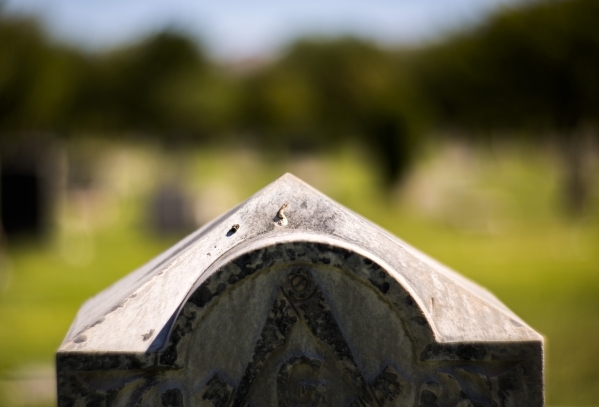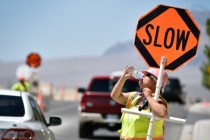Burning question: Why does Nevada lead in cremations?
If you live in Las Vegas, chances are you're going to burn.
Spurred on by its largest city, Nevada boasts the highest cremation rate in the U.S., with more than three-quarters of all deaths last year ending in ashes.
The national cremation rate was 47 percent in 2014, the highest it has ever been.
Barbara Kemmis is executive director of the Chicago-based Cremation Association of North America, or CANA, which closely tracks such things. She said an ever-larger number of Americans are opting to be cremated for numerous reasons, including perceived simplicity, shifting religious values, growing environmental consciousness, and good old-fashioned thriftiness.
You can get a cremation, a basic urn and a modest service for less than a third the cost of a traditional funeral with a coffin, headstone and grave, according to CANA.
Forty years ago, just 6.5 percent of Americans chose ashes over caskets. A decade ago the rate had grown to 32.4 percent. By 2019, CANA expects it to top 52 percent.
As for why the Silver State is at the leading edge of the trend, Kemmis quipped: "It's Nevada, right? Everybody is looking for a new way of doing things."
The real answer is a mix of the reasons above, plus transiency and geography.
Most Southern Nevada residents come here from somewhere else, and some of them have family ties and burial plots waiting for them back home. In death, "they have someplace else they need to be," said Larry Davis, general manager of Palm Mortuary-Downtown.
It's been this way for a while, too. Nevada has led the nation in cremations every year since 2006, and ranked no lower than second behind Hawaii since at least 2000, which is as far back as CANA's state-by-state numbers go.
Davis said about 70 percent of Palm's customers are cremated, and about a third are shipped out of the valley. A small percentage of them are tourists or conventioneers. For the loved ones of unlucky souls like that, cremation is often the cheapest and most practical option, he said.
Transporting a body in a casket can be complicated and expensive, easily costing up to $1,000 or more. Cremated remains can be carried on a plane by a family member or handed over to the U.S. Postal Service.
Davis said his mortuary has mailed as many as 30 boxes of cremains in a single month. They go across the country and around the world.
"Las Vegas is a melting pot," Davis said.
Each carefully packaged parcel is sent by registered mail at a cost of $40 to $85.
The Old Days of Dying
The growing popularity of cremation in Southern Nevada represents "sort of a reversion," said Nathan Harper, archaeologist for the Springs Preserve.
Cremation was the preferred funeral custom among some American Indians who lived and died in the region hundreds of years before the arrival of the first European settler. Although funeral practices varied from band to band and even from valley to valley, both the Southern Paiutes and the Patayan people were known to burn their dead along with the person's possessions, Harper said.
Before them, some Ancestral Puebloans living in the Moapa and Las Vegas valleys 800 to 1,500 years ago may have practiced a form of cremation, burying their dead in the floors of their pueblos or pit houses and burning the structures down on top of them. Molly Fierer-Donaldson, curator and archaeologist for the Lost City Museum in Overton, said evidence of the practice was documented during archaeological work in the 1920s and 1930s, ahead of the rising waters of Lake Mead.
Harper said the funeral traditions of some tribes in the valley eventually changed under the influence of Mormonism and Christianity to favor burial.
In the early days, people were buried in private plots, including one at the Stewart Ranch and "Boot Hill," along what is now Las Vegas Boulevard north of Washington Avenue.
Establishing a permanent cemetery became a priority shortly after the city was founded in 1905. One of the first attempts fell flat, said Dennis McBride, director of the Nevada State Museum.
The Las Vegas Cemetery was to be built on 40 acres near the present site of the Stratosphere Tower, about a mile and a half south of the city limits. That proved to be too far for people wishing to pay respects to loved ones, and the venture failed after about five burials, McBride said. Those bodies and others from the Stewart Ranch and elsewhere would later be moved to Woodlawn Cemetery, built in 1914 on 10 acres donated by Union Pacific Railroad.
Plans for Woodlawn were drawn up by civil engineer J.T. McWilliams, who also sketched the original Las Vegas town site 10 years earlier and wound up buried in the cemetery of his own design.
McBride said Woodlawn overlapped some of the community's early burial plots, although not perfectly. In the 1970s, when Owens Street was being widened next to the cemetery, some bodies were found outside the fence.
"There's very likely bodies still buried out in the direction of Foremaster Lane and Main Street," McBride said. "For whatever reason, that has always been a place where Las Vegas residents buried their dead."
Transiency was at play even in the early 20th century. McBride said few of the workers who died during construction of Hoover Dam were buried in Southern Nevada.
"They were sent back home, wherever that might be," he said.
Woodlawn was added to the National Register of Historic Places in 2006. It remains in operation today, just down the street from two other cemeteries, some funeral homes and two of Nevada's 22 increasingly busy crematories.
From Taboo to Tradition
Worldwide, cremation rates vary widely based on factors such as religion and available land. In Japan, almost all people are cremated. In the United Arab Emirates, where Islam forbids the practice, almost no one is.
Nevada's cremation rate puts it on par with the United Kingdom and New Zealand, according to CANA's figures.
Davis said the volume has increased so much over the years that Palm Mortuary upgraded its equipment to burn hotter and faster, allowing for more cremations in a day.
"For so long it was taboo," he said. "It's completely reversed."
Things were different when Davis started in the mortuary business 36 years ago.
"It was very traditional. It was church. It was burial. I was at church every day," he said. "It was more clear what we were doing."
Now people have more options and fewer ties to community and religion. Often they have spouses, children and stepchildren from different marriages who might want to weigh in on what happens next. Planning ahead has never been more important. Davis said he spends a lot more time these days refereeing family squabbles over funeral arrangements for people who never made their wishes known.
There's just no telling how fights like that might end. Lately, though, the odds favor a fire.
Contact Henry Brean at hbrean@reviewjournal.com or 702-383-0350. Find him on Twitter: @RefriedBrean
One sure bet: Death in Las Vegas


























